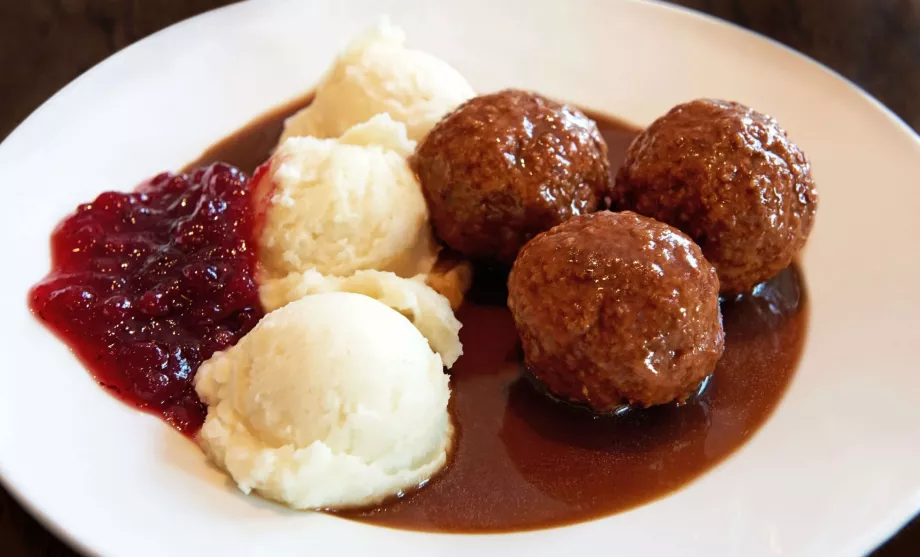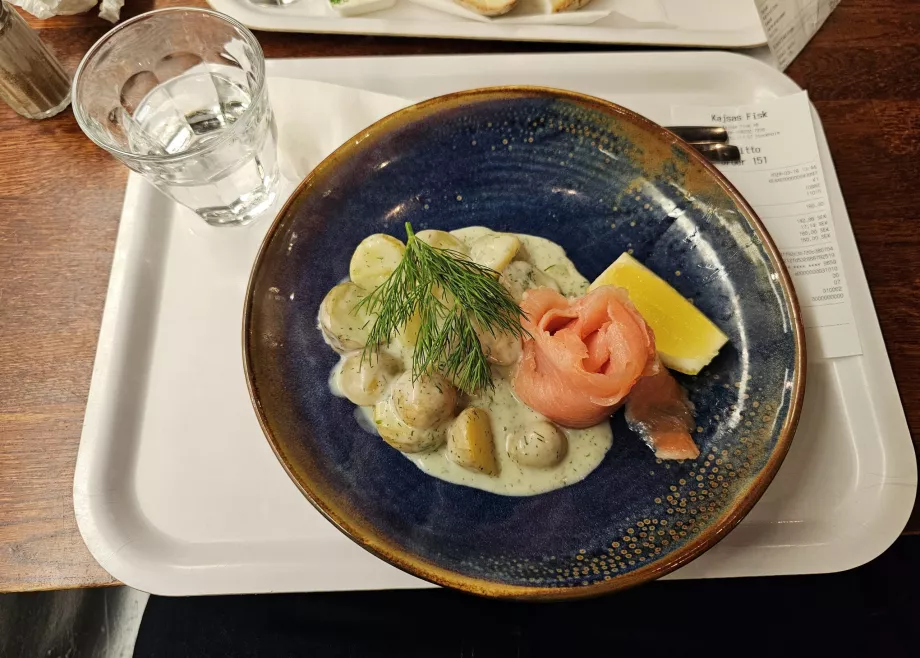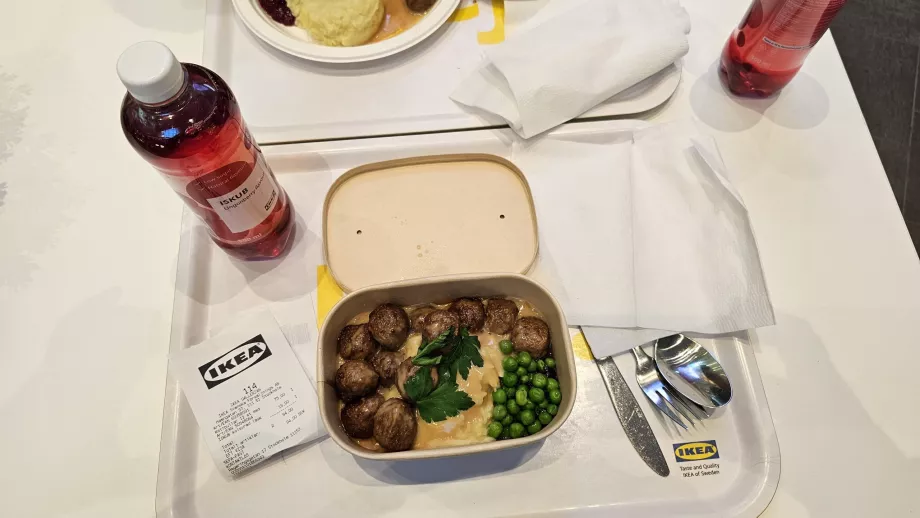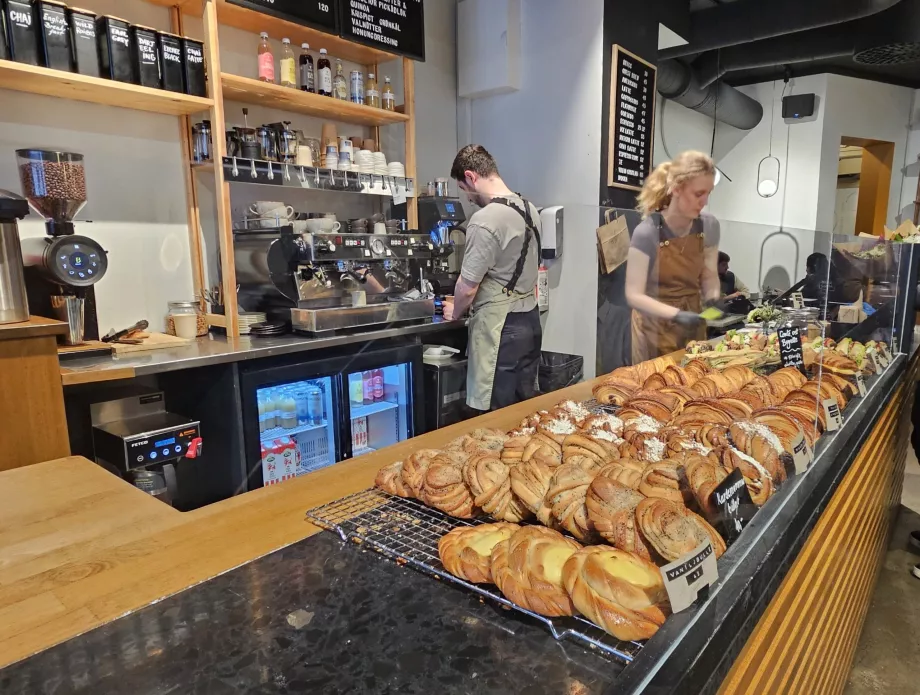Traditional food in Sweden

What to try in Sweden for local specialties? And where to go for cheap food?
Swedish cuisine
Historically, Swedish cuisine has not been very rich. The food of the vast majority of the population was limited to what could be grown or caught locally.
The diet therefore consisted mainly of porridge, bread, turnips (which were later replaced by potatoes), cabbage, legumes and soups.
Meat dishes were cooked mostly from fish, pork, possibly venison and wild birds. Elk (älg) and reindeer (ren) meat is also commonly available, most often prepared as steak served with potatoes and cranberries.
Swedes are very fond of sweets. Local bakeries offer a large variety of specialities.
Typical Swedish specialities
These dishes should not be missed in Sweden.
Meatballs
Swedish meatballs are not just a simple dish, but one of the symbols of the country. Meatballs are commonly made with ground beef and pork and served with mashed potatoes and cranberries.
The dish is typical throughout Scandinavia, but as a Swedish dish it has been made famous worldwide by the IKEA furniture store chain, which has been serving them as a main dish in its dining rooms for decades.
Salmon
Salmon is a very popular dish and is prepared in dozens of different ways. The most popular is salted salmon with potatoes and dill sauce.
Surströmming
A dish infamous for hundreds of YouTube videos of people from abroad trying to eat it, but despite the incredible smell, it induces vomiting rather than appetite.
Surströmming is a preserved sour herring made by fermenting fish meat, which produces a strong smell. The fish is extremely salty and the smell is so intense that surströmming is banned from eating in many public buildings.
Typically, the tin is opened under running water and served with bread.
Surströmming is a seasonal food and is on sale in shops from about mid-August until stocks run out, rarely until the following spring. Surströmming is most commonly sold in northern Sweden, where it can be found in every supermarket. Very little is on sale in the south.
Count on the fact that surströmming is an expensive food and one 400 gram tin costs around 450 sek.
Ärtsoppa
Sweden's most famous soup is made from yellow peas and various ingredients are added at will, most commonly chicken.
Sill (pickled herring)
Herring is one of the most popular sea fish, which Swedes absolutely love.
It is most often marinated in various sauces with different spices, so herring dishes vary widely regionally. Herring is one of the most popular starters or light dishes for dinner or snacks.
Kroppkakor
A typical dish of southern Sweden is dumplings filled with bacon or smoked meat served with cranberry sauce.
It is one of the most inexpensive and at the same time very tasty and hearty dishes.
Pytt i Panna
For centuries the food of the poor has remained popular even today because of its speed and unpretentiousness.
It is a leftover food. What you have left at home, you mix together. The basic ingredient is potatoes, which are cut into chunks and you can put almost anything into them to taste. Most often pork, tomatoes, bacon or cucumbers.
Smörgåstårta
This unique savoury dessert is made up of many second sandwiches, ham, cheese or vegetables. Smörgåstårta is made for festive occasions, but is also sold in some bakeries.
Desserts and sweet
Sweet buns filled with cinnamon and especially cardamom, which is very popular in Sweden, are extremely popular.
Stop by one of the many cafés in the morning and buy one of each sweet bun. We guarantee you'll have a much better breakfast than the bland continental tables in your hotel.
The northern parts of Sweden also produce absolutely fantastic buns with baked cranberries, both in sweet and savoury form.
Semla
Small sweet doughnuts with whipped cream on top are typically filled with almond cream and flavoured with cinnamon, cardamom or left unflavoured.
Great for breakfast and afternoon coffee.
Kladdkaka
The most popular cake among Swedes is made of chocolate with a large proportion of butter. That's why it has a slightly oily and very thick consistency.
Kladdkaka is softened with whipped cream and raspberries.
How to eat like a local
Swedes normally eat at home. When someone invites you home for dinner, it's a sign that they really appreciate you. They go to restaurants less often. Otherwise, it's really common for Swedes to cook at home in advance and bring their food to work/school in a box.
That's also why you won't find many local restaurants with local cuisine in Sweden, and when they do exist, they tend to focus on tourists and have very high prices. In restaurants it is convenient to have a lunch menu.
The cheapest local food (from 69 sek), in the form of meatballs, can be found in the dining rooms of the furniture store IKEA.
What's most important to Swedes? Going for "fika." That means going to a café, having a coffee, something sweet and chatting with friends. In contrast to restaurants, cafés are ubiquitous and can be found in cities large and small.
Classic fast-food joints with burgers and fries are ubiquitous. In Sweden, the local company MAX Burgers is the leader, but there are also McDonald's and KFC. Very often you will also come across pizzerias or kebab shops.
Hot dogs are also popular at 7-Eleven or Pressbyrån, which can be found even in the smallest towns.
Usual prices in restaurants
- Eating in a restaurant on the lunch menu - 130 sek
- Eating in a restaurant, no specials - 170 sek at a cheaper restaurant, but more commonly from 220 sek upwards
- Beer - 60 sek
- Cocktail - 140 sek
- Pizza - 100 sek
- McDonald's menu - 110 sek
- Water - 25 sek
- Hotdog - 30 sek
Any questions left?
If you have any questions or comments about the article...





